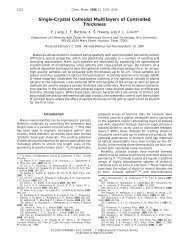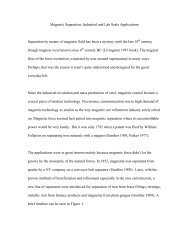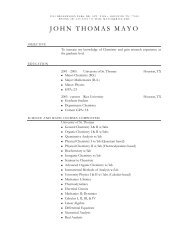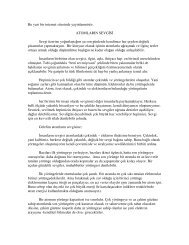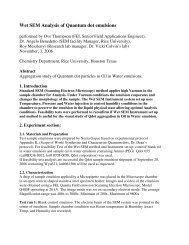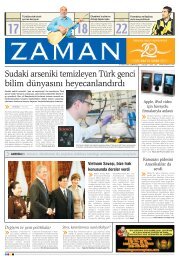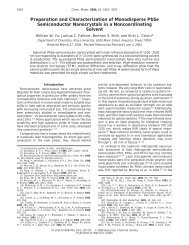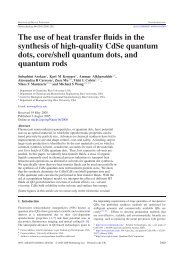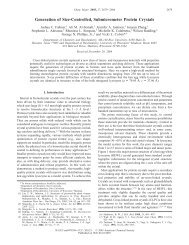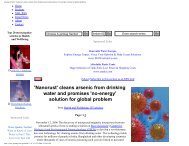Nano-C60 cytotoxicity is due to lipid peroxidation
Nano-C60 cytotoxicity is due to lipid peroxidation
Nano-C60 cytotoxicity is due to lipid peroxidation
You also want an ePaper? Increase the reach of your titles
YUMPU automatically turns print PDFs into web optimized ePapers that Google loves.
7594<br />
environmental fate. Given the enormous range of<br />
nanoparticle types, morphologies and surface chem<strong>is</strong>tries,<br />
as well as the uncertain form of nanoparticles in<br />
future applications, <strong>to</strong>xicological testing that only<br />
provides a measure of hazard <strong>is</strong> not useful. Instead,<br />
<strong>to</strong>xicology in th<strong>is</strong> emerging area must provide a bas<strong>is</strong> for<br />
predicting systematically how a nanoparticle’s biological<br />
behavior relates <strong>to</strong> its structure, composition and<br />
morphology. In vitro testing provides a cost-effective<br />
means for such studies, and as th<strong>is</strong> report illustrates, cell<br />
culture experiments are well suited for developing<br />
mechan<strong>is</strong>tic models <strong>to</strong> inform material development.<br />
We hope th<strong>is</strong> work will set a standard for future efforts<br />
<strong>to</strong> characterize the environmental and health impacts of<br />
other classes of engineered nanoparticles. Ultimately,<br />
such proactive environmental and <strong>to</strong>xicological studies<br />
will be vital <strong>to</strong> ensure the nanomaterials design process<br />
yields both effective and safe technologies.<br />
Acknowledgements<br />
We thank Marcella Estrella for technical ass<strong>is</strong>tance<br />
with the cell cultures; Prof. Jane Grande-Allen for<br />
instrument use; and John D. Fortner, Delina Lyon, and<br />
Adina M. Boyd for supplying the nano-<strong>C60</strong> sample. Th<strong>is</strong><br />
work was financially supported by the Center for<br />
Biological and Environmental <strong>Nano</strong>technology (NSF<br />
EEC-0118007).<br />
References<br />
[1] Da Ros T, Pra<strong>to</strong> M. Medicinal chem<strong>is</strong>try with fullerenes and<br />
fullerene derivatives. Chem Commun 1999;8:663–9.<br />
[2] Da Ros T, Spallu<strong>to</strong> G, Bou<strong>to</strong>rine A, Pra<strong>to</strong> M. Fullerene<br />
derivatives as potential DNA pho<strong>to</strong>probes. Aust J Chem<br />
2001;54:223–4.<br />
[3] Colvin VL. The potential environmental impact of engineered<br />
nanomaterials. Nat Biotechnol 2003;21:1166–70.<br />
[4] Sayes C, Fortner J, Lyon D, Boyd A, Ausman K, Tao Y,<br />
Sitharaman B, Wilson L, West J, Colvin VL. The differential<br />
<strong>cy<strong>to</strong><strong>to</strong>xicity</strong> of water soluble fullerenes. <strong>Nano</strong> Lett 2004;4:1881.<br />
[5] Andrievsky GV, Klochkov VK, Karyakina EL, McHedlov-<br />
Petrossyan NO. Studies of aqueous colloidal solutions of fullerene<br />
C-60 by electron microscopy. Chem Phys Lett 1999;300:392–6.<br />
[6] Andrievsky GV, Klochkov VK, Bordyuh AB, Dovbeshko GI.<br />
Comparative analys<strong>is</strong> of two aqueous-colloidal solutions of C-60<br />
fullerene with help of FTIR reflectance and UV-V<strong>is</strong> spectroscopy.<br />
Chem Phys Lett 2002;364:8–17.<br />
[7] Deguchi S, Alargova RG, Tsujii K. Stable d<strong>is</strong>persions of<br />
fullerenes, C-60 and C-70, in water. Preparation and characterization.<br />
Langmuir 2001;17:6013–7.<br />
[8] Scrivens W, Tour J, Creek K, Pir<strong>is</strong>i L. Synthes<strong>is</strong> of 14C-labeled<br />
<strong>C60</strong>, its suspensions in water, and its uptake by human<br />
keratinocytes. J Am Chem Soc 1994;116:4517–8.<br />
[9] Cheng XK, Kan AT, Tomson MB. Naphthalene adsorption and<br />
desorption from Aqueous C-60 fullerene. J Chem Eng Data<br />
2004;49:675–83.<br />
ARTICLE IN PRESS<br />
C.M. Sayes et al. / Biomaterials 26 (2005) 7587–7595<br />
[10] Fortner J, Lyon D, Falkner J, Boyd A, Hotze E, Sayes C, Tao Y,<br />
Guo W, Ausman K, Colvin V, et al. <strong>C60</strong> in water: nanocrystal<br />
formation and biological effects. Env Sci Technol 2005, in press.<br />
[11] Legrand C. Lactate dehydrogenase (LDH) activity of the number<br />
of dead cells in the medium of cultured eukaryotic cells as marker.<br />
J Biotechnol 1992;25:231–43.<br />
[12] Decker T, Lohmann-Matthes M-L. A quick and simple method<br />
for the quantitation of lactate dehydrogenase release in measurements<br />
of cellular <strong>cy<strong>to</strong><strong>to</strong>xicity</strong> and tumor necros<strong>is</strong> fac<strong>to</strong>r (TNF)<br />
activity. J Immunol Methods 1988;15:61–9.<br />
[13] Mossman T. Rapid colorimetric assay for cellular growth and<br />
survival: application <strong>to</strong> proliferation and <strong>cy<strong>to</strong><strong>to</strong>xicity</strong> assays. J<br />
Immunol Methods 1983;65:55–63.<br />
[14] S<strong>to</strong>scheck C. Quantitation of protein. Methods Enzymol<br />
1990;182:50–69.<br />
[15] Bradford M. A rapid and sensitive for the quantitation of<br />
microgram quantitites of protein utilizing the principle of proteindye<br />
binding. Anal Biochem 1976;72:248–54.<br />
[16] Aust S. CRC Handbook of methods for oxygen radical research.<br />
Boca Ra<strong>to</strong>n, Fl: CRC Press; c1985.<br />
[17] Pap EHW, Drummen GPC, Winter VJ, Kooij TWA, Rijken P,<br />
Wirtz KWA, Op den Kamp JAF, Hage WJ, Post JA. Ratiofluorescence<br />
microscopy of <strong>lipid</strong> oxidation in living cells using<br />
C11-BODIPY 581/591. FEBS Lett 1999;453:278–82.<br />
[18] Drummen GPC, Op den Kamp JAF, Post JA. Validation of the<br />
peroxidative indica<strong>to</strong>rs, c<strong>is</strong>-parinaric acid and parinaroyl-phospho<strong>lipid</strong>s,<br />
in a model system and cultured cardiac myocytes. BBA-<br />
Mol Cell Biol Lipids 1999;1436:370–82.<br />
[19] Derfus AM, Chan WCW, Bhatia SN. Probing the <strong>cy<strong>to</strong><strong>to</strong>xicity</strong> of<br />
semiconduc<strong>to</strong>r quantum dots. <strong>Nano</strong> Lett 2004;4:11–8.<br />
[20] Shvedova AA, Castranova V, K<strong>is</strong>in ER, Schwegler-Berry D,<br />
Murray AR, Gandelsman VZ, Maynard A, Baron P. Exposure <strong>to</strong><br />
carbon nanotube material: assessment of nanotube <strong>cy<strong>to</strong><strong>to</strong>xicity</strong><br />
using human keratinocyte cells. J Toxicol Env Health-Part A<br />
2003;66:1909–26.<br />
[21] Warheit DB, Laurence BR, Reed KL, Roach DH, Reynolds<br />
GAM, Webb TR. Comparative pulmonary <strong>to</strong>xicity assessment of<br />
single-wall carbon nanotubes in rats. Toxicol Sci 2004;77:117–25.<br />
[22] Cusan C, Da Ros T, Spallu<strong>to</strong> G, Foley S, Jan<strong>to</strong> J, Seta P,<br />
Larroque C, Tomasini M, An<strong>to</strong>nelli T, Ferraro L, et al. A new<br />
multi-charged C-60 derivative: synthes<strong>is</strong> and biological properties.<br />
Eur J Org Chem 2002;17:2928–34.<br />
[23] Corona-Morales AA, Castell A, Escobar A, Drucker-Colin R,<br />
Zhang LM. Fullerene C-60 and ascorbic acid protect cultured<br />
chromaffin cells against levodopa <strong>to</strong>xicity. J Neurosci Res<br />
2003;71:121–6.<br />
[24] Dugan LL, Gabrielsen JK, Yu SP, Lin TS, Choi DW. Buckminsterfullerenol<br />
free radical scavengers reduce exci<strong>to</strong><strong>to</strong>xic and apop<strong>to</strong>tic<br />
death of cultured cortical neurons. Neurobiol D<strong>is</strong> 1996;3:129–35.<br />
[25] Dugan LL, Turetsky DM, Du C, Lobner D, Wheeler M, Almli<br />
CR, Shen CK-F, Luh TY, Choi DW, Lin TS. Carboxyfullerenes<br />
as neuroprotective agents. Proc Natl Acad Sci USA<br />
1997;94:9434–9.<br />
[26] Bowry VW, Ingold KU, S<strong>to</strong>cker R. Vitamin-E in human lowdensity-lipoprotein—when<br />
and how th<strong>is</strong> antioxidant becomes a<br />
prooxidant. Biochem J 1992;288:341–4.<br />
[27] Bur<strong>to</strong>n GW, Ingold KU. Au<strong>to</strong>xidation of biological molecules. 1.<br />
The antioxidant activity of vitamin-E and related chain-breaking<br />
phenolic antioxidants invitro. J Am Chem Soc 1981;103:6472–7.<br />
[28] Cillard J, Cillard P, Griffon B, Sinbandhit S, Sergent O. Nitric<br />
oxide as antioxidant and prooxidant in iron-mediated oxidative<br />
stress. Free Radical Biol Med 2004;36:S51.<br />
[29] d’Eril GVM, De Luca G, Albertini R. An analogue of vitamin E<br />
has either antioxidant or prooxidant activity during oxidation of<br />
low-density lipoprotein: a descriptive and mechan<strong>is</strong>tic study. Clin<br />
Chem 2001;47:A53.



